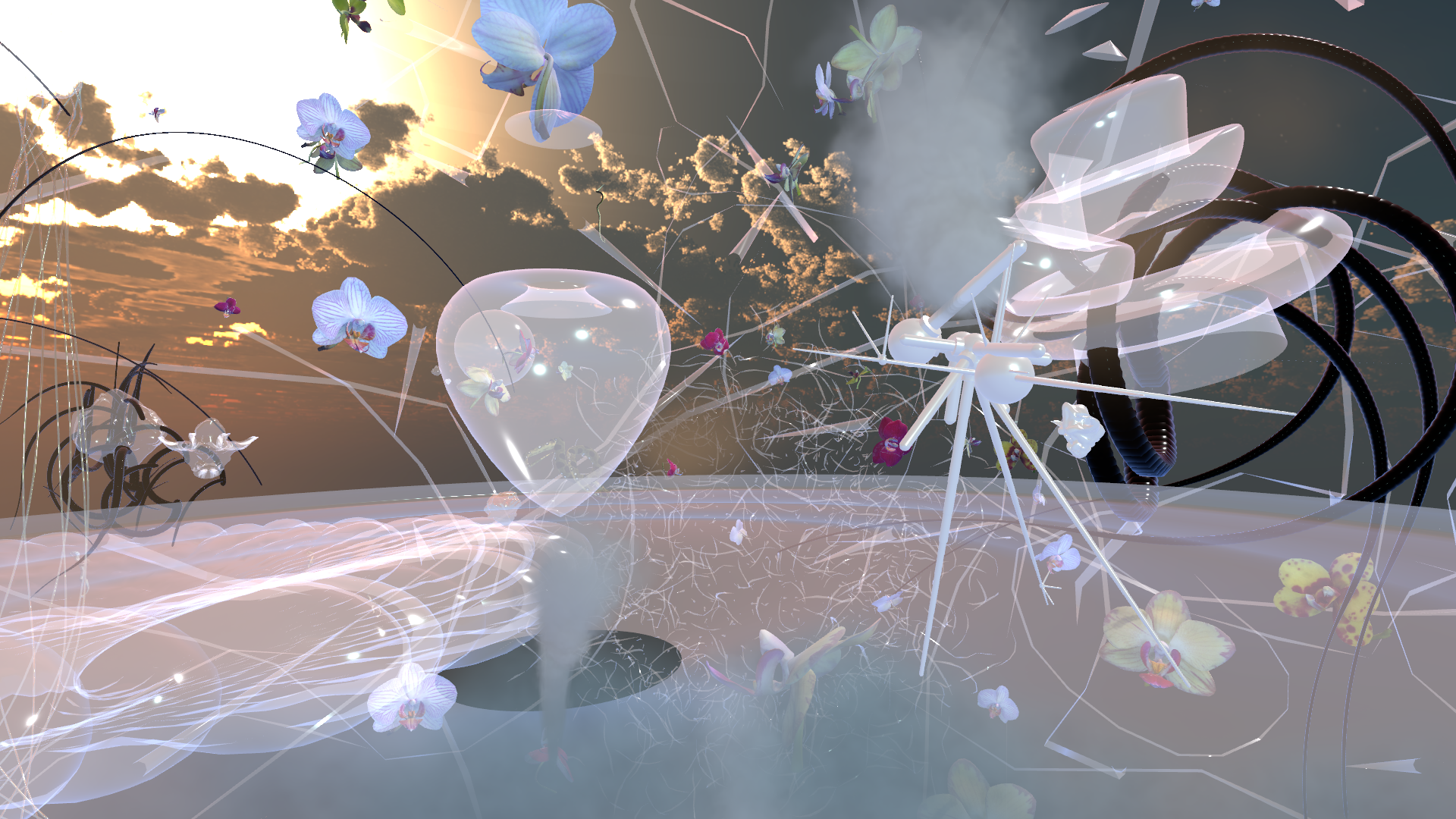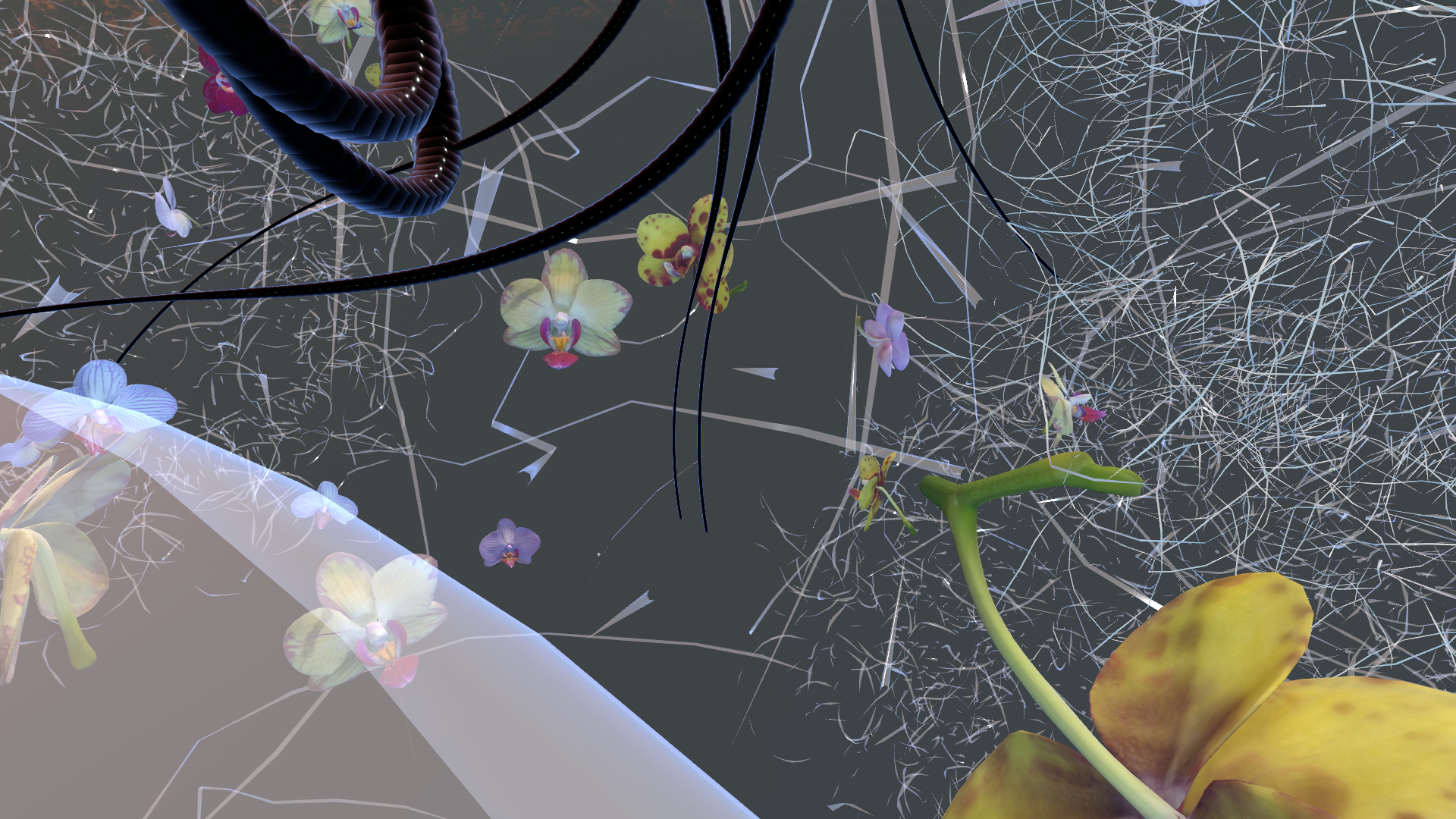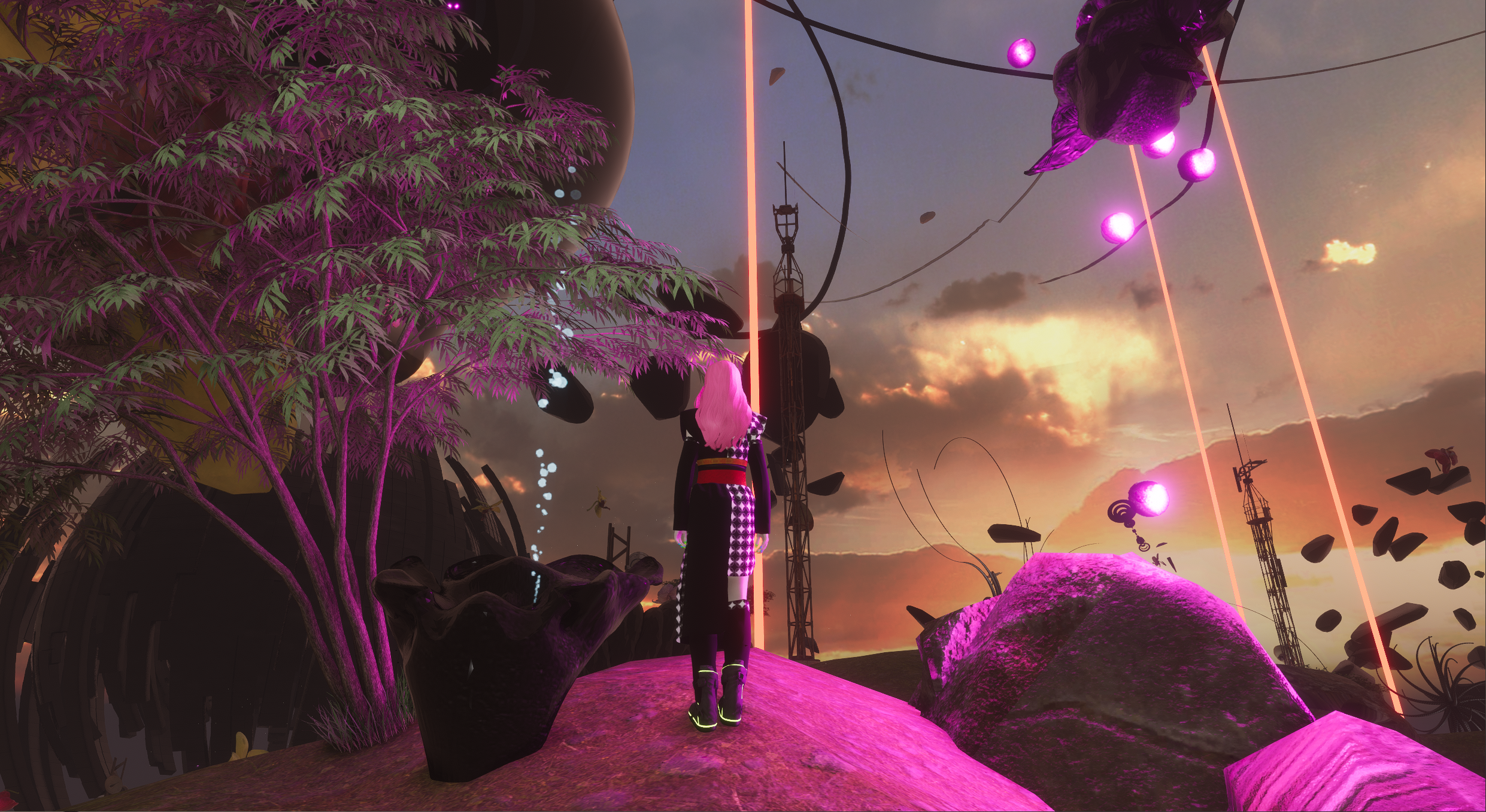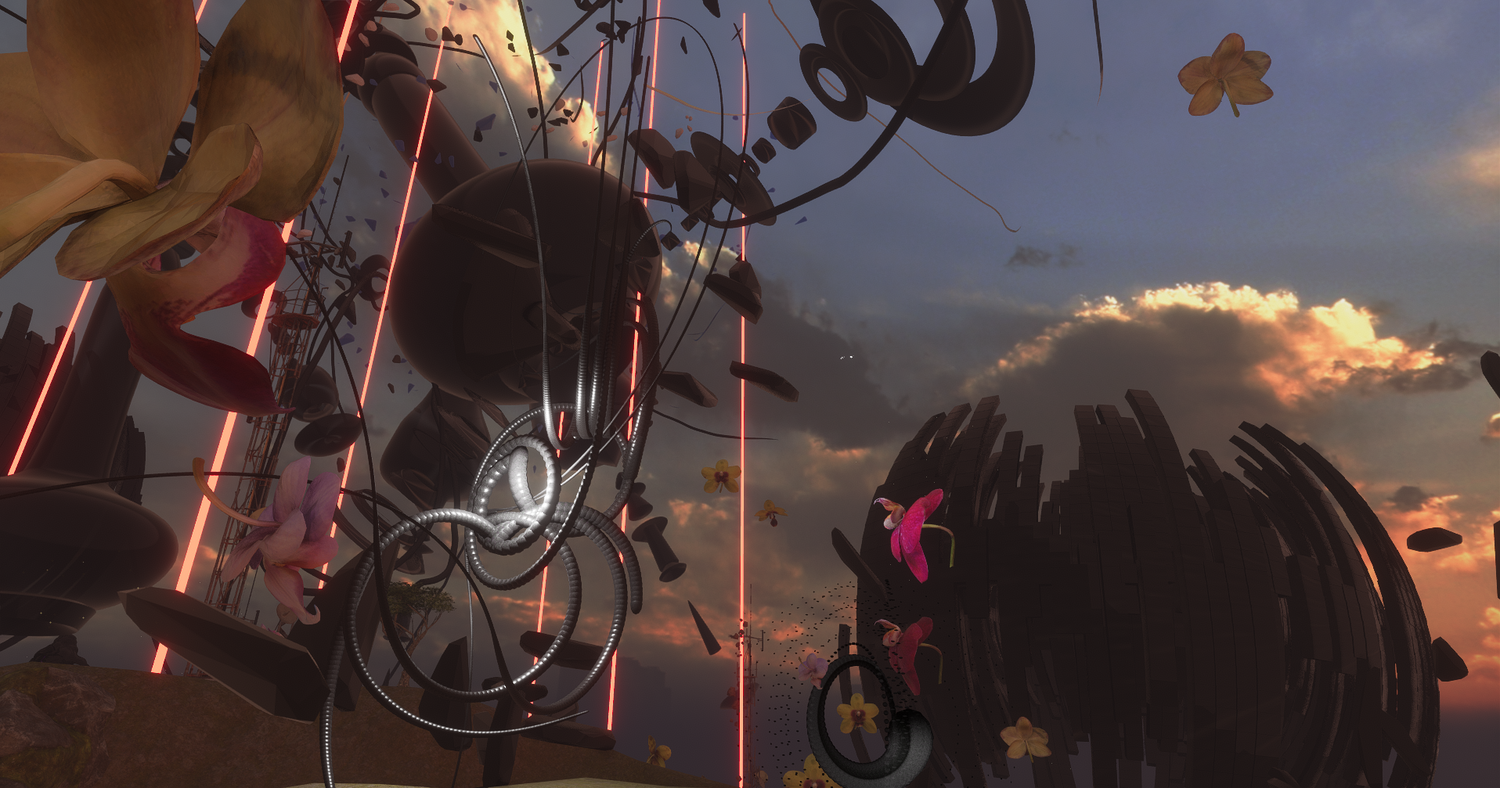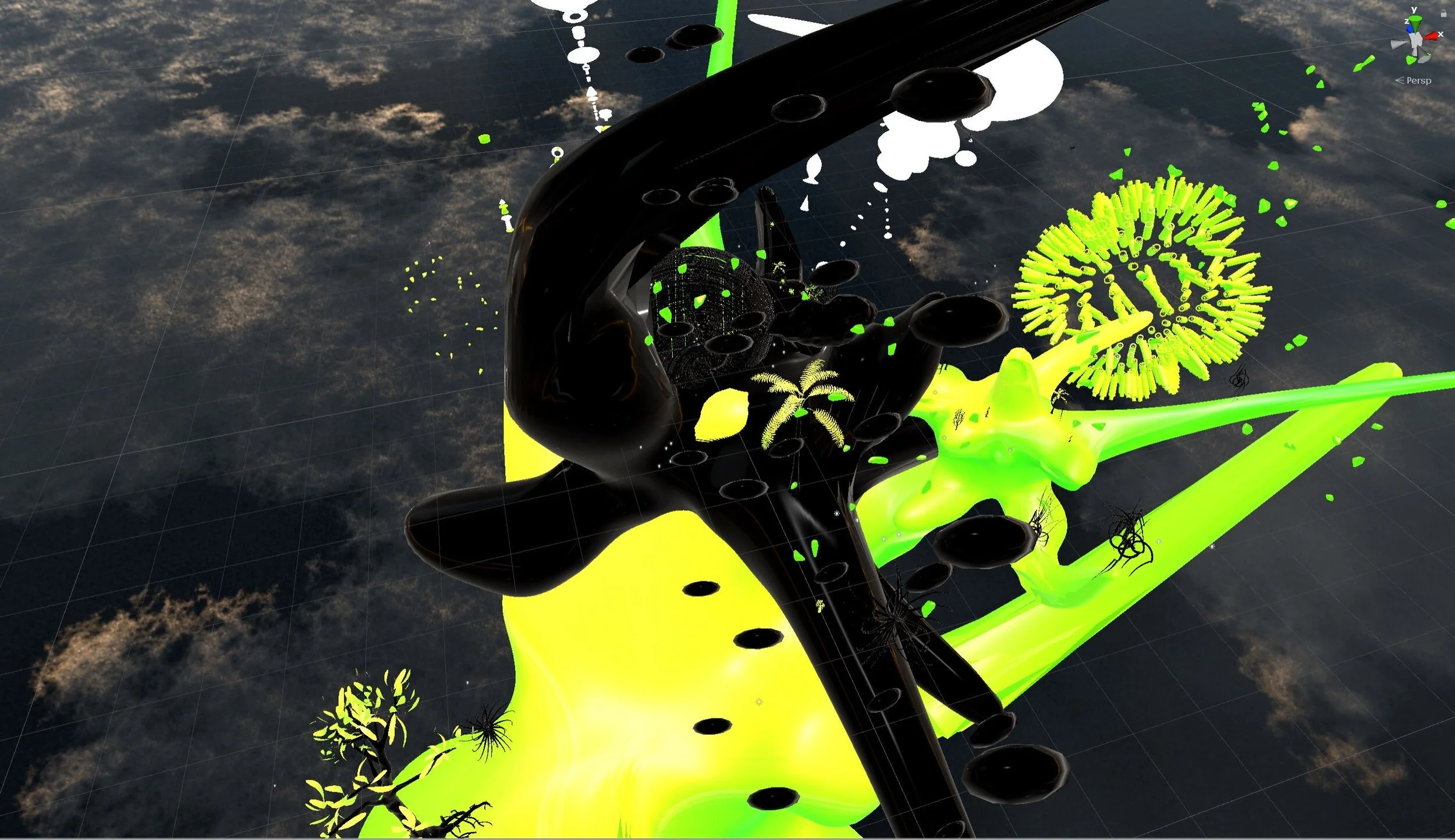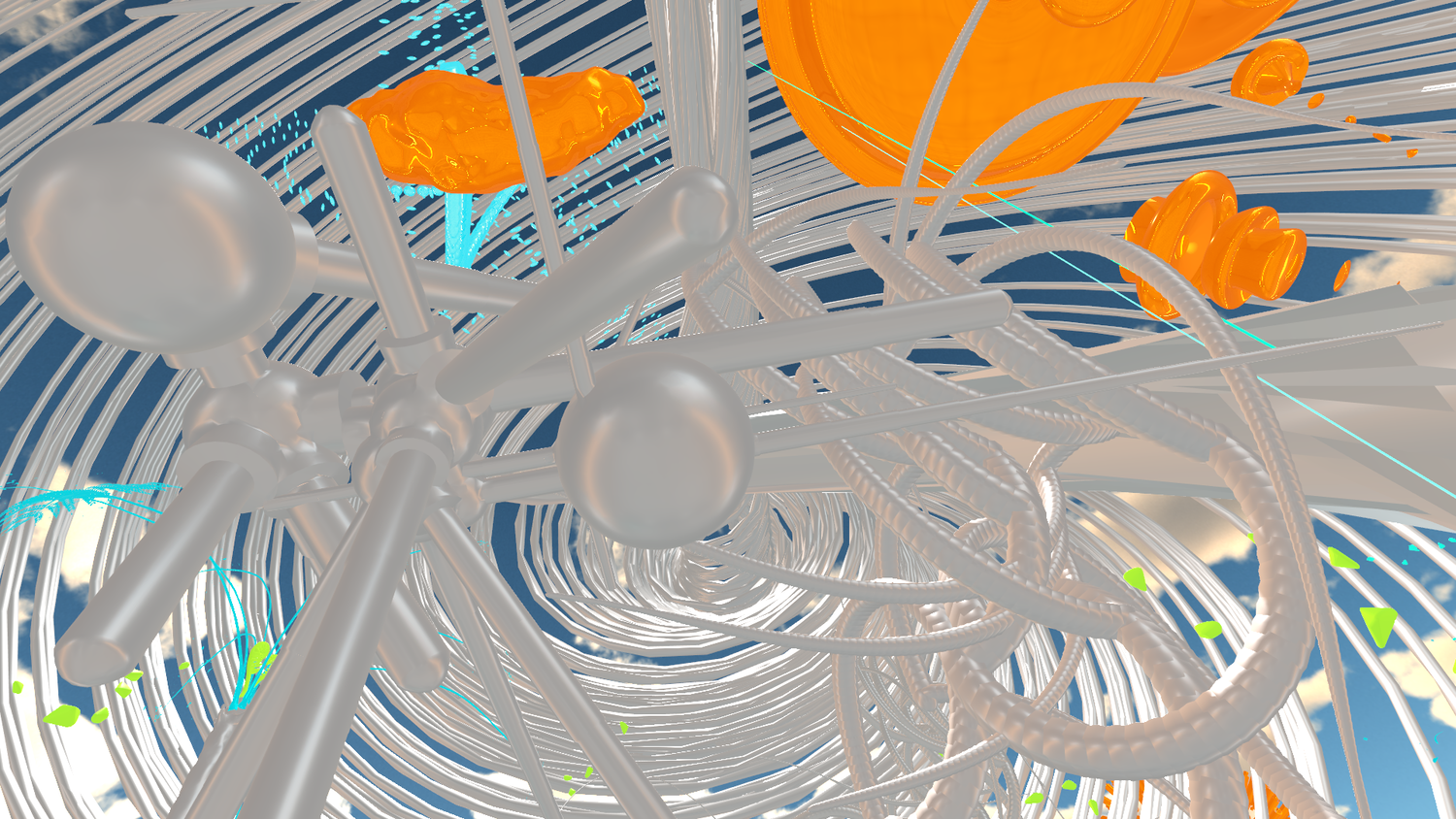Genesis
Genesis (AvantGarden: Sphere4)
Virtual reality art installation published on VRChat / video work, 2021.
3D graphics, world building, digital sculptures: Tanja Vujinovic
Sphere4 ₲Ɇ₦Ɇ₴ł₴ AV set used for training of deep neural network by Tanja Vujinović (visual material from Universal Objects and AvantGarden series) and Sasa Radic (sound);
Sound: Tanja Vujinovic and LUZ1E
Training of deep neural network: Dr Vid Podpečan, Department of Knowledge Technologies, Jožef Stefan Institute
Coproduction: SciArtLab, Jožef Stefan Institute
Production: Tanja Vujinovic / Ultramono, 2021.
Consulting
Dr Jelena Guga, researcher
Thimster, Graphics design master
Dr Vid Podpečan, Department of Knowledge Technologies, Jožef Stefan Institute
Ivan Stanić, curator and artist
Derek Snyder, researcher and editor
Friends from VRChat
Sphere4 Genesis is a virtual garden that enables us to immerse ourselves into an ongoing soundscape generated with the help of custom-made artificial intelligence software. A deep neural network was trained to generate sound through samples of minimal techno music. This world contains machinic and biomimetic-inspired objects that developed sentience through machine learning. The world is full of orchids, snakes and generated snake-like objects – AvantGarden machines, while the Dyson sphere-inspired objects float, encircling stars and capturing their energy to be used in the world. As Félix Guattari puts it, “its chaosmic Universe can be constellated with […], vegetal, animal, cosmic or machinic...becomings.” As new planes of the AvantGarden unfold, we get to know their elements, which develop lives of their own. The world of Sphere4 Genesis is published on VRChat, an amalgam of a computer game and a social platform that offers its users possibilities of organizing events and publishing content in the form of virtual worlds and avatars. VRChat could also be described as a “Non-game game”, a class of software offering the player unbound possibilities of freeform play, identity and a great degree of self-expression, exploration and interaction, without the limits of conventional or imposed goals and objectives. All Sphere4 worlds published on the VRChat platform contain “seeds” of the AvantGarden ecosystem, with the addition of newly developed ones made especially for Sphere4.
Technical description (written by Dr Vid Podpečan)
Our sound generation uses end-to-end neural audio generation model called SampleRNN. This is a recurrent neural network which generates one audio sample at a time and uses a hierarchy of modules, each operating at a different temporal resolution. In particular, we use the PRiSM's implementation of SampleRNN in TensorFlow 2 (https://github.com/rncm-prism/prism-samplernn). The input audio data which is a collection of minimal techno soundtracks is downsampled to 16kHz and sliced into 8 second chunks which are then used to train the network. The hyperparameters of the model were optimized and one of the best combinations was used to train the final model. During the training for 250 epochs intermediate models were stored at every 10th epoch. The model starts to generate useful audio data after approximately 60-100 epochs so we used all available useful intermediate models to generate audio samples while also varying the sampling temperature parameter.
Genesis, Virtual reality art installation, 2021.
Love at the Edge of the Playspace
Love at the Edge of the Playspace (AvantGarden: Sphere4)
Virtual reality art installation published on VRChat / video work, 2021..
3D graphics, world building, digital sculptures: Tanja Vujinović
Sound: Tanja Vujinović and LUZ1E
Coproduction: SciArtLab, Jožef Stefan Institute
Production: Tanja Vujinovic / Ultramono, 2021.
Consulting
Dr Jelena Guga, researcher
Thimster, Graphics design master
Ivan Stanić, curator and artist
Derek Snyder, researcher and editor
Friends from VRChat
Love at the Edge of the Playspace is a virtual alchemy garden rich in foliage, flowers and sentient objects that soothe our senses. It is a virtual reality world dedicated to unity, closeness, love and intermediary devices.
Desire to connect is omnipresent throughout the grid of agents that feed off each other. How does one connect with the world nowadays? Do we need intermediate agents to connect with the Other? As a place of probabilities, in Félix Guattari’s words, “its chaosmic Universe can be constellated with […], vegetal, animal, cosmic or machinic…becomings”. Besides interhuman, we are now getting into relationships with some of these becomings and their amalgams. Actors in the networks of intense connections can appear in endless varieties of forms. The suspense of constantly building up desire to connect is the constant state of being in our hypernatural world.
Love at the Edge of the Playspace, Virtual reality art installation, 2021.
CLUB 2.0
Club 2.0 (AvantGarden: Sphere4)
Virtual reality art installation published on Sansar / video work, 2011.
3D graphics, world building, digital sculptures, sound: Tanja Vujinović
Additional assets for the world and avatars: Sansar Store
Production: Tanja Vujinović / Ultramono, 2021.
Consulting
Arijana Filipić, Department of Biotechnology and Systems Biology, National Institute of Biology
Prof. George Poinar, College of Science at Oregon State University
Dr Vid Podpečan, Department of Knowledge Technologies, Jožef Stefan Institute
Ivan Stanić, curator and artist
Friends from Sansar
AvantGarden Club 2.0 by Tanja Vujinovic is a virtual reality art installation from her series of artworks for social VR spaces. Club 2.0 is a virtual environment that enables us to explore virtual reality as a social space of connectedness, featuring a minimal techno audio-visual set or special events scheduled by the author. It is inhabited by generated Dyson Sphere-like devices, objects inspired by the shapes of snakes and plants, and Tanja’s digital sculptures called Proto-machines, futuristic retro devices that take care of the environment.
Club 2.0 is published on Sensar, an amalgam of a computer game and a social platform that offers its users possibilities of organizing events and publishing content in the form of virtual worlds and avatars. Sansar could also be described as a “Non-game game”, a class of software offering the player unbound possibilities of freeform play, identity with a great degree of self-expression, explorational interaction, without the limits of conventional or imposed goals and objectives.
The world is full of orchids as representations of most seductive and diverse flowers, while the Dyson sphere-inspired objects float, encircling stars and capturing their energy to be used in the world. As new spheres of the AvantGarden unfold, we can observe their elements form lives of their own. As Félix Guattari puts it, “its chaosmic Universe can be constellated with […], vegetal, animal, cosmic or machinic...becomings.”
How does one connect with another being nowadays?
Music is one such medium, essential for both celebrations and play. Vibrations of sound waves as invisible wires spread emotion through triggering impulses. As a liquid agent distributed among actors of a particular world, it can connect the invisible strings among people, and tie them into a temporary network of vibrant energy flows. This liberating, transcending of the self through the crowd dancing in togetherness is also one form of play. It is a communal dance, it is a primal activity in unfolding, a cosmic unity of sorts, it is an intimacy with the universe.
Hakim Bey within "The Temporary Autonomous Zone (TAZ)" talks about the parties as republics of gratified desires. Escaping the regular rhythms of life, according to Bey, helps one to discover the real edges of reality. Like in a dream, VR inhabitants experience shifting of reality references. These may seem like temporary acts of anarchist dreams from autonomous zones and a re-awakened culture of free festival with care, cultivation, and love as a driving force in mind.
Club 2.0, Virtual reality art installation, 2021.
CLUB
Club (AvantGarden: Sphere4)
Virtual reality art installation published on VRChat / video work, collaborative events, 2020..
3D graphics, world building, digital sculptures, sound: Tanja Vujinović
3D objects of carboniferous plants: Dariusz Andrulonis for edukator.pl
Chenocebus allodapus and Strychnos electri plant 3D object modelling: Thimster, Graphics Design Master
Production: Tanja Vujinović / Ultramono, 2020.
Consulting
Kristina Bukač, Informatics engineer
Prof. George Poinar, College of Science at Oregon State University
Dr Jelena Guga, researcher
Thimster, Graphics Design Master
Dr Vid Podpečan, Department of Knowledge Technologies, Jožef Stefan Institute
Ivan Stanić, curator and artist
Derek Snyder, researcher and editor
Friends from VRChat
AvantGarden: Sphere4 Club is a virtual environment that enables us to explore virtual reality as a social space of connectedness. This art installation features a minimal techno audio-visual set or special events scheduled by the hosts. It is inhabited by generated Dyson Sphere-like devices, objects inspired by the shapes of snakes and plants, and reconstructed plants from the Earth's past.
Sphere4 is published on VRChat, an amalgam of a computer game and a social platform that offers its users possibilities of organizing events and publishing content in the form of virtual worlds and avatars. VRChat could also be described as a “Non-game game”, a class of software offering the player unbound possibilities of freeform play, identity and a great degree of self-expression, exploration and interaction, without the limits of conventional or imposed goals and objectives.
This sphere of the AvantGarden features several plants from the Earth's past. These are Strychnos electri, a poisonous flower, four Carboniferous plants (Psaronis, Calamites, Kordait, Sphenophyllum) and Chenocebus allodapus, a flower that was modelled after what is possibly the very first flower to blossom on Earth. Strychnos electri and Chenocebus allodapus were studied by George Poinar, one of the world's experts on plant and animal life forms that were preserved in amber. While being alluring but also essential for human survival, the first flowers may have existed up to 100 million years ago, and many paleobotanists work on the puzzle of how the first flowers looked. With Chenocybus allodapus representing one of the earliest angiosperm lineages known, Strychnos electri belongs to the family of highly poisonous plants that, together with snake like objects in Sphere4, creates twisted instances of Asclepius rods alluding to the medicine-poison dichotomy. The world is full of orchids as representations of its most seductive and diverse flowers, while the Dyson sphere-inspired objects float, encircling stars and capturing their energy to be used in the world. As new spheres of AvantGarden unfold, we can observe their elements, how like entities form lives of their own. As Félix Guattari puts it, “its chaosmic Universe can be constellated with […], vegetal, animal, cosmic or machinic...becomings.”
Vilem Flusser, a key theoretician and philosopher of media, said that if we upgrade our apparatuses so we do not need to operate them continually, we could spend more time playing. For Flusser, play had the status of a supremely important human activity. Play can be understood as a series of acts of recreation, relaxation, creativity, being in the moment, structuring our free time and devoting ourselves to activities we enjoy. Through participation in the building of synthetic worlds and characters, games can be sought out as part of the process of "self-determination", part of Flusser’s idea of "humanization", which is, according to him, an overcoming of "thrownness" – the burdens of one’s birth impositions. Playful situations alternatively set up new temporary relations among participants and might include synthetic characters and worlds that have flourished together with the development of computer technologies. Video games offer temporary options of immersing oneself into alternative, modified or new lives with endless possibilities of modifications. We always played games: acts of pretending, of creating, building, influencing elements around ourselves, hunting or immersing ourselves into alternative landscapes. We learned how to get along with other people in small improvised spaces, in arenas, in both real life and virtual playgrounds.
How does one connect with another being nowadays? Music is one such medium, essential for both celebrations and play. Vibrations of sound waves as invisible wires spread emotion through triggering impulses. As a liquid agent distributed among actors of a particular world, it can connect the invisible strings among people, and tie them into a temporary network of vibrant energy flows. This liberating, transcending of the self through the crowd dancing in togetherness is also one form of play. It is a communal dance, as a primal activity in unfolding, a cosmic unity of sorts, or intimacy with the universe.
Hakim Bey within "The Temporary Autonomous Zone (TAZ)" talks about the parties as republics of gratified desires. Escaping the regular rhythms of life, according to Bey, helps one discover the real edges of reality. Like in a dream, VR users experience shifting of reality references. These may seem like temporary acts of anarchist dreams from autonomous zones and a re-awakened culture of free festival with care, cultivation, and love as a driving force in mind.
Club 2.0, Virtual reality art installation, 2020.
Genesis / Love at the edge of the playspace / Club project References
Benyus, Janine M. Biomimicry Innovation Inspired by Nature. HarperCollins, 1997.
“Non-Game.” In Wikipedia, February 1, 2020. https://en.wikipedia.org/w/index.php?title=Non-game&oldid=938583267.
“Noosphere.” In Wikipedia, December 5, 2020. https://en.wikipedia.org/w/index.php?title=Noosphere&oldid=992389119.
“The Dream of the Fisherman’s Wife.” In Wikipedia, December 1, 2020. https://en.wikipedia.org/w/index.php?title=The_Dream_of_the_Fisherman%27s_Wife&oldid=991665659.
“VRChat.” In Wikipedia, June 21, 2020. https://en.wikipedia.org/w/index.php?title=VRChat&oldid=963682380.
Channel 4 News. Slavoj Žižek: On Corbyn, the Election, Brexit and Fake News, 2017. https://www.youtube.com/watch?v=xN2ZGSX0cIE.
Horvat, Srećko. The Radicality of Love. Cambridge, UK ; Malden, MA: Polity, 2016.
Leslie, Esther. Synthetic Worlds Nature, Art and the Chemical Industry. Reaktion Books, 2005.
Nachmanovitch, Stephen. Free Play: Improvisation in Life and Art (version Reprint). Reprint. Tarcher, 1991.
Parisi, Luciana. Abstract Sex: Philosophy, Bio-Technology and the Mutations of Desire. Transversals. London ; New York: Continuum, 2004.
Saitō, Tamaki, Keith Vincent, Dawn Lawson, and Hiroki Azuma. Beautiful Fighting Girl. Minneapolis: University of Minnesota Press, 2011.
William Williamson. The Question of Love, 2020. https://www.youtube.com/watch?v=CytC6A-K8c4
TEDx Talks. Love Has To Be Reinvented | Srecko Horvat | TEDxBrussels, 2016. https://www.youtube.com/watch?v=7hFy02TSH4U.
Viktor, Pelevin. IPhuck 10. Beograd: Plato, 2019.
“Shinto.” In Wikipedia, October 9, 2020. https://en.wikipedia.org/w/index.php?title=Shinto&oldid=982611897.







